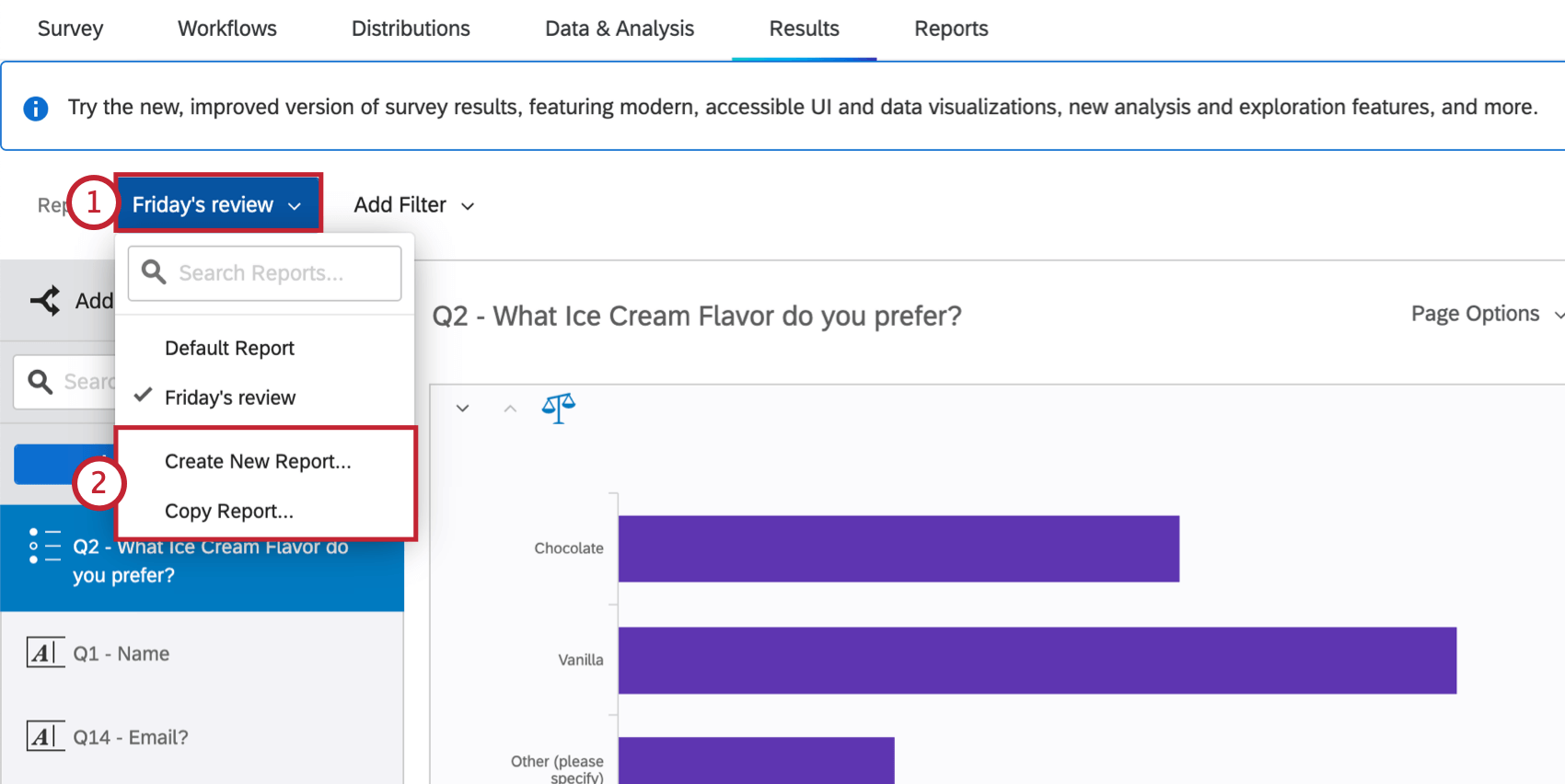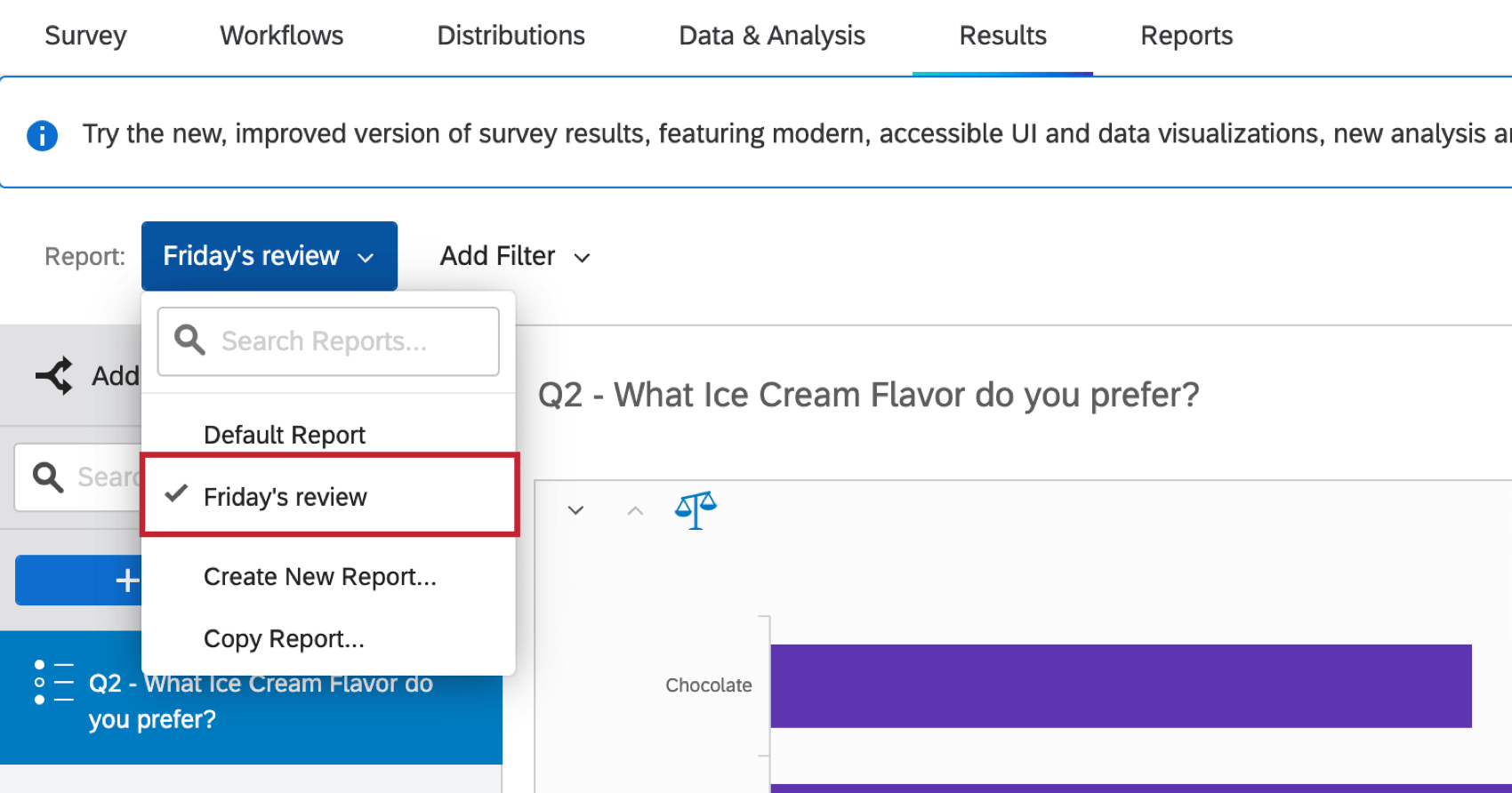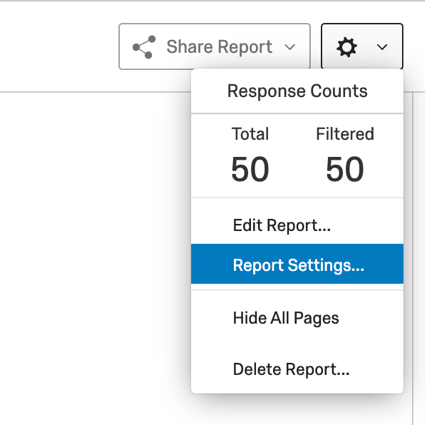Results-Reports Basic Overview

About Results-Reports
Results-reports are designed to give you a quick and simple visualization of your survey results. Each question in your survey will have a visualization pre-made for it. However, there are many customization options available to you to help you build a report to fit your needs.
To access results-reports, click Results in your survey project.

Types of Projects
Legacy Results are available in a few different types of project. This includes:
- Survey projects
Qtip: This includes survey projects within programs, such as surveys within Brand programs.
- Conjoint and MaxDiff projects
Qtip: Read more about Results functionality specific to Conjoints and MaxDiff.
- Many guided XM Solutions
Navigating Results-Reports
The main features of results-reports include:
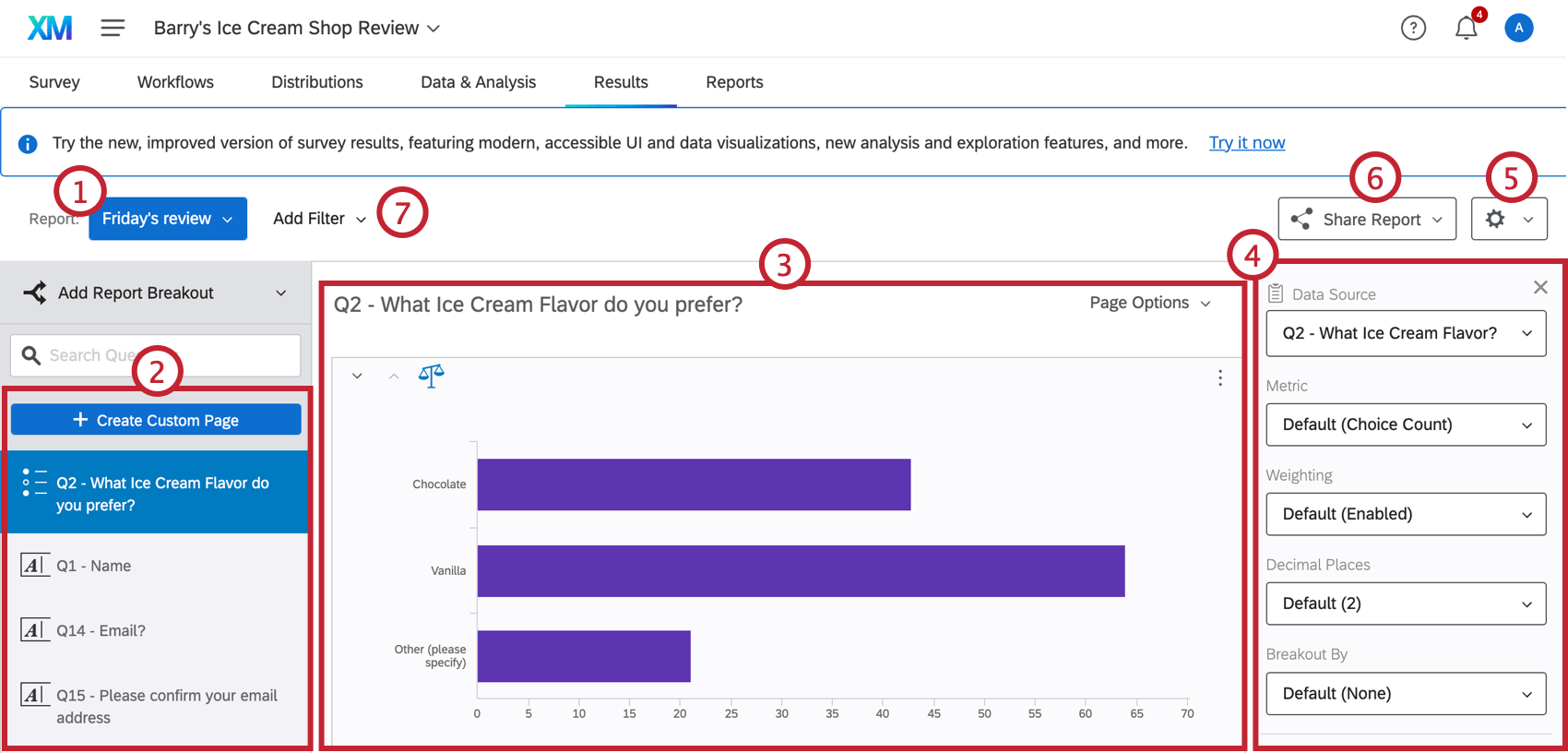
- The report dropdown menu allows you to create and copy reports, as well as switch between existing reports.
- By default, every question in your survey will have its own page. You can edit these default pages, or create your own custom pages.
- In the center of the page are your data visualizations. These display your survey data in easy-to-digest charts, graphs, and tables. See results-reports visualizations for an overview of every visualization type.
- Select a visualization to pull up the visualization editing window. Use this window to customize your visualization to your liking.
- The gear icon brings you to your global results-reports settings, where you can determine the default settings for your report, including applying custom color palettes to every visualization.
- The Share Report button lets you share your report in various ways; you can export your report as a file, create a public version of your report, or send your report as an email.
- Click Add Filter to filter your report to look at a subset of your survey data.
Creating and Copying Results-Reports
If you want to create a new report, you can make a copy of your existing report or start from scratch.
Editing Results-Reports Pages & Adding Visualizations
Visit the linked pages to learn more about editing results-reports pages.
- Custom vs. Question Pages: This page describes the difference between default (i.e. question) pages and custom pages.
- Creating Custom Pages: Create new pages in your report where you have full control over the page content.
- Page Options: The page options that are used to export, move, hide, and delete pages.
- Adding Visualizations: Add visualizations to your results-reports pages.
- Adding Images and Text: Add images and text to your results-reports pages.
- Moving and Managing Pages: Rearrange and hide the pages and visualizations in your results-reports.
Using Results-Reports Filters
You can filter your entire results-report to remove data you don’t need. For example, in the below image, we filter our results to show NPS Detractors since we are interested in analyzing only their data.
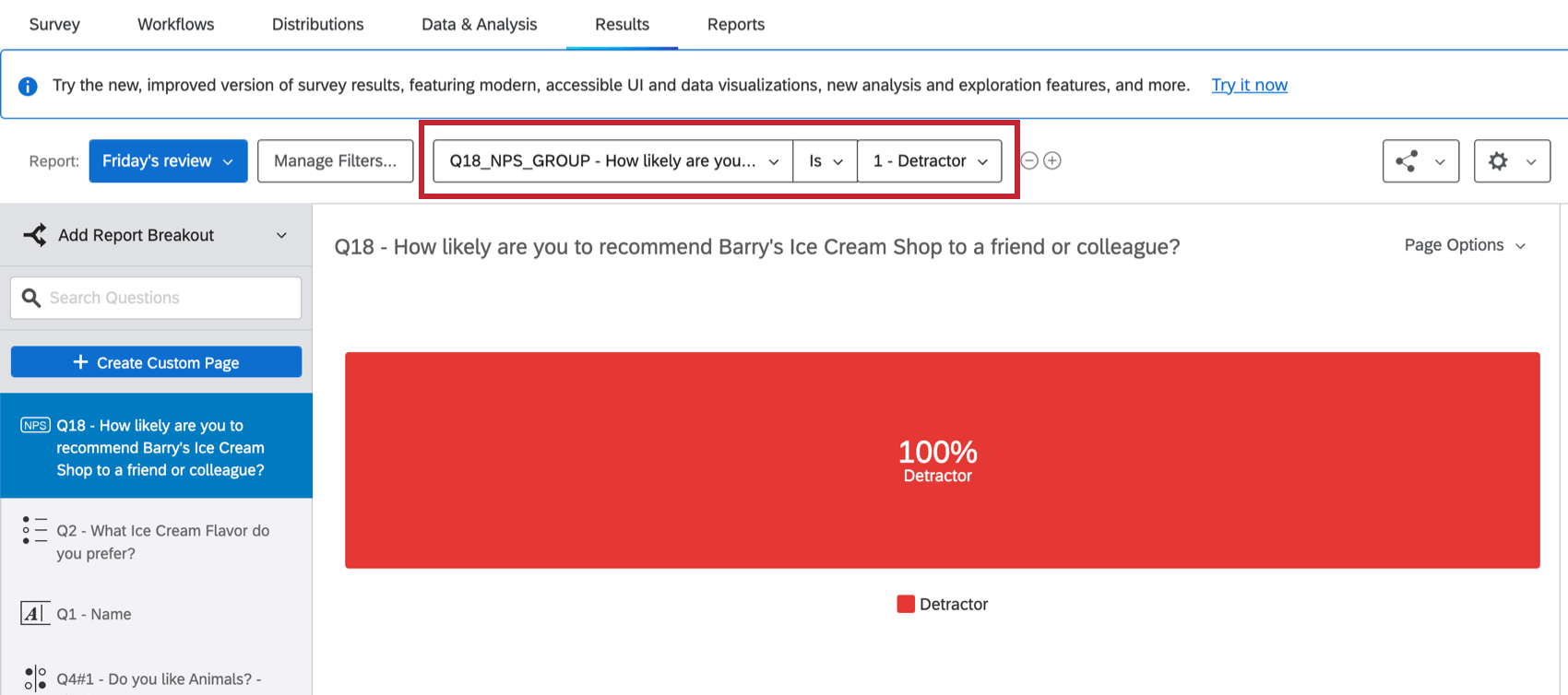
For help with results-reports filters, see Filtering Results-Reports. This page contains all the information you will need to filter your results-report, including how to add a filter, building filter logic, and saving and reusing filters.
Sharing Results-Reports
There are many ways to share a Results-Report. To share your results-report, click Share Report in the top right and then select how you want to share your report.
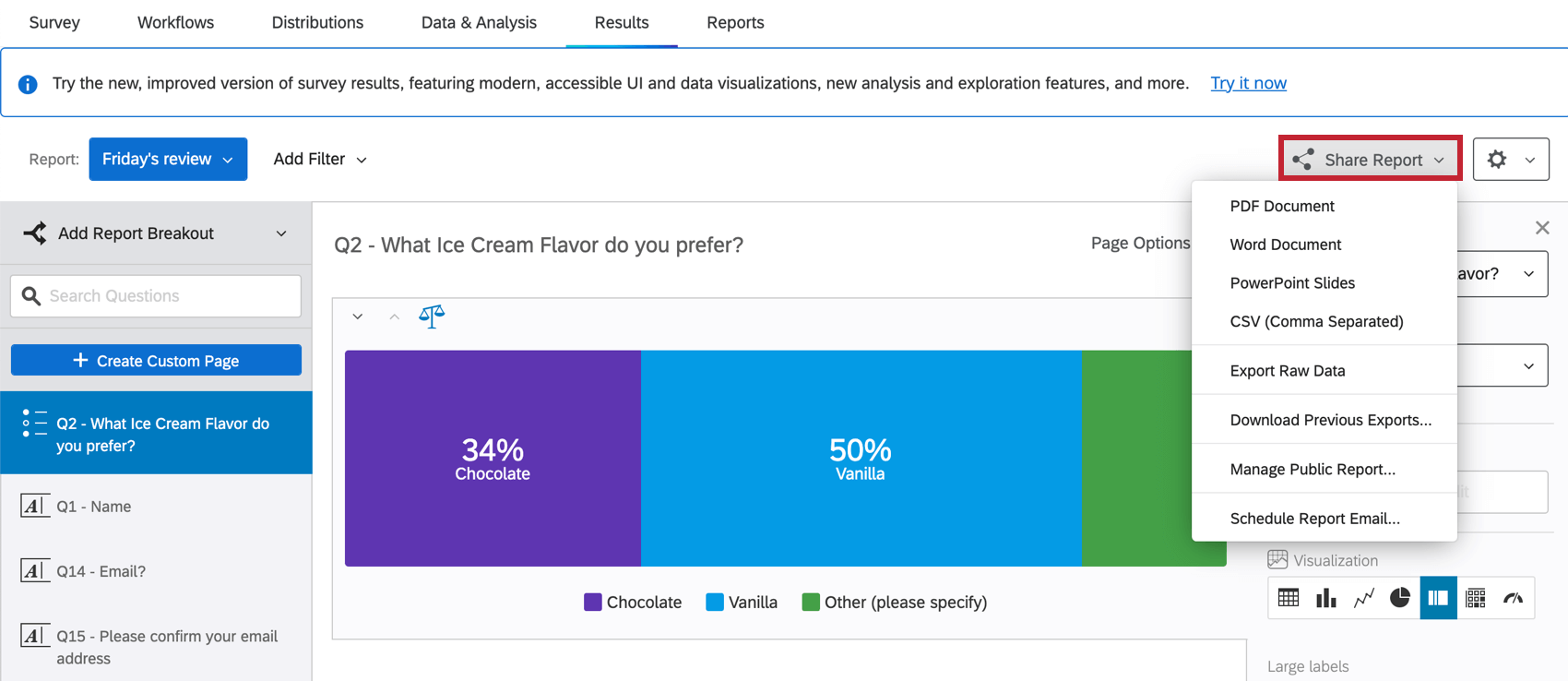
The methods for sharing your report include:
- Sharing a Project: Share a project (survey) with a colleague’s Qualtrics account and grant access to your results-reports. Visit the linked page for more information. Note, this sharing option is found on the projects page, not within the results-report.
- Exporting Results-Reports: Generate and share a digital copy of your report in a PDF, Word, PowerPoint, or CSV format. See the Exporting Results-Reports support page for more details.
- Managing Public Results-Reports: Create a version of your report that is available via a public web link. You can lock your report with an access code. See the Managing Public Results-Reports support page for more details.
- Scheduling Results-Report Emails: Send your results-report as an email attachment. See the Scheduling Results-Report Emails support page for more details.
Using Results-Reports Breakouts
Breakouts allow you to display data from different samples side by side. In the below example, we asked survey respondents to indicate the last clothing item they purchased. We then added a breakout for gender to see how people of different genders responded. By using breakouts, we can see how different demographics answer the same question.
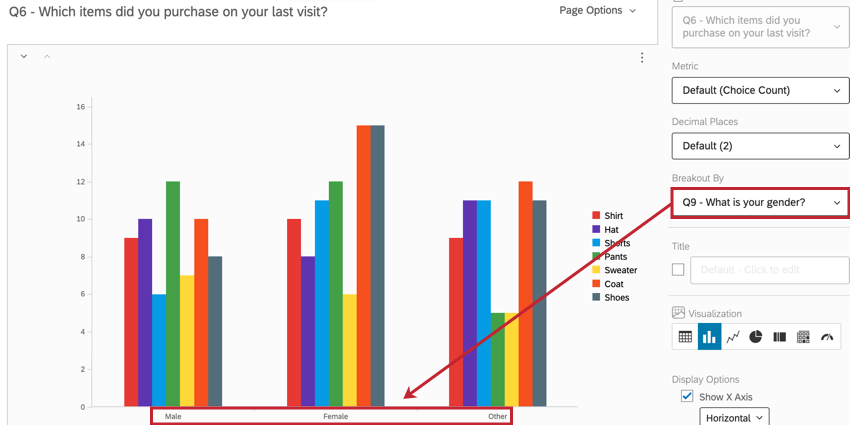
For an in-depth guide on using breakouts, see Results-Reports Breakouts.
Editing Report Settings
To access your global results-reports setting, click the Settings (gear) icon and then select Report Settings.
Your global results-reports settings control the following aspects of your report:
- Choose what metric is selected by default in visualizations.
- Choose the default number of decimal places in visualizations.
- Choose the default color palette used in visualizations. You may choose from a library of prebuilt palettes, or build your own.
- Determine the default font and spacing for any text in your report.
- Determine what visualizations are included in your report by default.
- Enable response weighting in your report.
- Determine other visualization customization options, such as what totals are included in tables.
You can save your settings so that you can easily reuse them in a future report. For more information about every option in global settings, see Global Results-Reports Settings.
FAQs
- Why am I receiving the error message "Data source misconfigured for this visualization"?
-
This means that your data source for the specified visualization is not compatible with the visualization in its current state. Several possibilities could be happening here:
- The question was originally a different question type. Click on the visualization. If this doesn't resolve the issue, re-select the data source (e.g., the question linked to the visualization).
- A breakout was applied that the visualization did not accept. Change the visualization to a different type, and then change it back to the original visualization type.
- An incomplete results filter can cause this. Removing or finishing the filter can solve the issue. See Filtering Results for more details.
- How can I share live results?
- Why is my contact list information not appearing in any of my reports?
-
Only Embedded Data fields that are saved in the Survey Flow are included in reports. Even if those Embedded Data fields are included in the contact list, if they’re not also set in the Survey Flow, they won’t appear in the reports.
If you forgot to put Embedded Data in the Survey Flow, you can add it to your data retroactively, so long as there are values in the contact list. See the Embedded Data support page for further instruction.
Note that if the contact list information you’re trying to download was not included in the contact list at the time the members took the survey, retroactively adding the Embedded Data fields to the Survey Flow will not add that information to the reports later. - I want to use a certain visualization for my data, but that visualization option isn’t appearing when I choose my data source. Why?
-
Depending on the particular data sources you select, you'll have different visualizations available to use. The reason for this is that not every visualization makes sense with every data source. For example, it doesn't make sense to have a Bar Chart option for Text Entry questions.
Some question types offer more than one data source (i.e., more than one way to represent their data), so you might be able to pick an alternative data source and use the desired visualization. - Can I change the default settings on a report instead of editing each visualization one at a time?
-
Yes, you can do this with both types of reporting.
You can learn how to change your default settings on Results-Reports on the Global Results-Reports Settings support page, and you can learn how to change the default settings for Advanced-Reports on the Global Advanced-Reports Settings support page. - My visualizations from different questions are all on different pages in my Results-Report. Can I put them on the same page?
-
Yes. Click on Create Custom Page on the left-hand side of the report to add a page that allows you to add visualizations from different questions.
Note that in Advanced-Reports, you customize every page. - Can I add other columns of information to my visualizations?
-
In order to add additional columns of information to a visualization, start with a Text Entry question. In Results-Reports, use a Paginated Table. In Advanced-Reports, use a Results Table.
In the visualization editing pane for either visualization, you will be able to select Add Additional Columns.
No other visualization can add additional columns like this. - Can I break down the information in a visualization into groups based on other data?
-
Yes, you can subdivide a visualization by selecting Breakout By in the visualization editing pane. You will then select the question, metadata, or Embedded Data field you would like to break the visualization out by.
See Breakouts for Advanced-Reports or Breakouts for Results-Reports, depending on the reporting you are using. - Can I hide pages in my Results-Report without deleting them so I can use them later?
-
Yes. You can hide pages by hovering over the question text in the menu on the left-hand side of the page and unchecking the checkbox that appears. You can recheck the page at any time to unhide the page in your report.
- How do I rename my report?
-
- Results-Reports: Click the gear in the upper-right and select Edit Report. A new window will open with a field for the name.
- Advanced-Reports: Go to File and choose Rename.
- I don't have the tab described on this page! What do I do?
-
There are a few reasons why you may not have access to certain tabs in your Qualtrics account.
- If you're working on a survey that's been shared with you and you're missing a tab, it's likely the survey owner did not give you permission to access that tab. Contact the survey owner about receiving access.
- Some features require you have certain user permissions before you can use them. Reach out to your Brand Administrator about enabling the correct permissions.
- Some features are add-on features not included in standard licenses. Contact your Account Executive if you have questions about what's included in your license.
